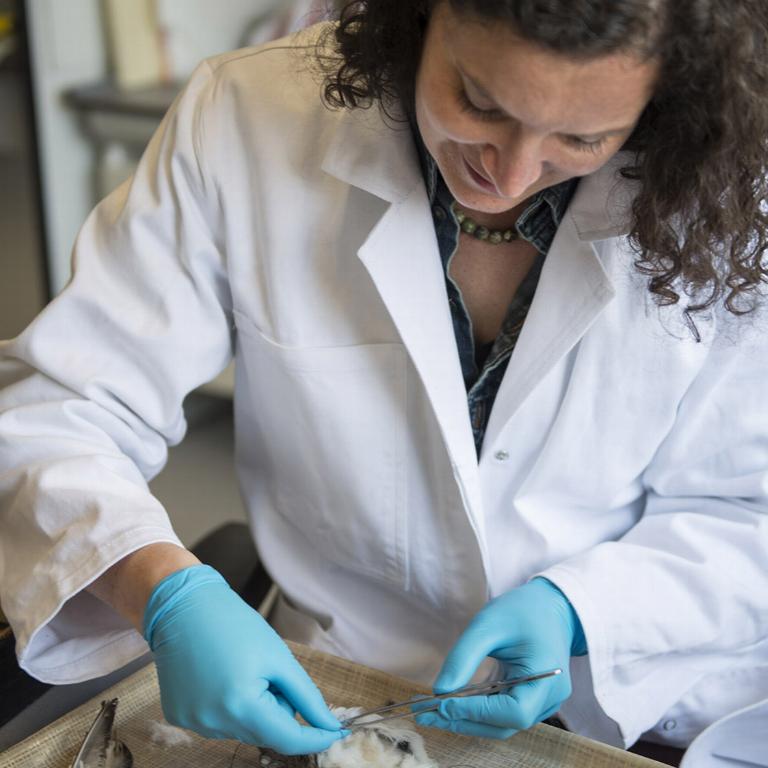
Every now and then I am invited to do a special after hours event. Usually this is some kind of live preparation demonstration, the type I used to do regularly in LiveScience in our old museum (and will do again after our new building opens!). I really enjoy doing them. A few weeks ago I prepared astudy skin for 'Nacht van Ontdekkingen', an annual event devoted to art and science that takes place throughout the city of Leiden. I was not alone, as many Naturalis colleagues participated: giving lectures, quizes, showing visitors about the fossil history of the Netherlands, taking part in debates, etc. And we were just a small part of the many events that were going on, from light shows and a floating soprano in the canal to live music and even tai chi.
The theme of the evening was 'Time', which is the perfect theme around which to prepare a specimen for the collections! Whenever we add a newly prepared specimen to the collection (whether a bird, mammal, shell, or insect or any other type of specimen), we are essentially putting a timestamp in the collection. I prepared a common quail from the province of Utrecht found in June 2018. This bird is totally different than a quail from the fall, or a quail from Limburg, or a quail from Utrecht in 1918. Besides being different individuals, they are different sexes and ages, occuring in different areas and eating eating different types of seeds. Visitors to the collection who see the whole series can then make inferences as to how populations of quail (or mammals, or shells, or insects) change over time. Perhaps the specimens get bigger, or smaller, or change color, or start eating different food, or stop occurring in one province and move into another. Quail in the Netherlands fluctuate in population numbers, which is reflected in the collection. They nest in fields, are affected by the timing of hay harvesting as well as weather. If the farmer goes to harvest hay when the quail is sitting on eggs or has young, the birds are frequently killed. Also, in wet years many fewer young are produced. So some years quail populations are high, and some years low. You can see this reflected in the collection here at Naturalis.
The quail I prepared had been found dead in the garden of a home near Utrecht. The homeowner had donated it to Naturalis. I selected this bird from the freezer primarily because of the size; though songbirds are my favorite, the tiny size makes it a bit difficult for visitors to see what I am doing. But the quail had so much going on; it was the perfect pick to do in front of the public. This quail was a female and had three almost fully developed eggs in her oviduct, and I could see scars on the ovary that indicated that 4 eggs were already laid. This means she would have produced a clutch of at least 7 eggs! Surprisingly, the bird also had new feathers growing (molting) in a few places on the body. Molting requires a lot of energy, as does producing young, so in most birds these two events do not occur simultaneously. In addition I checked the stomach which had a few seeds in it, but also quite a few stomach stones. These small stones are eaten ( especially by seed eating birds like quail) in order to help them grind up food in their stomach. Finally, I tried to discern how the bird died. It had a lot of trauma on it, but it was not the same kind as being hit by a car or a window, which always is in the head. This bird had a few holes in the skin, which indicates a cat kill. Pet cats kill millions of birds every year.
There were so many people who came by to learn about quails, the importance of collections, and bird biology that I was not able to finish the study skin that night. But on Monday in the laboratory I got it done! After it dries and then is disinfected it will be the 579th Common Quail on our collection. Best of all, next year when our new building opens I will be able to work in front of the public much more frequently. I cannot wait!
Written by Becky Desjardins,
Taxidermist, Naturalis Biodiversity Center